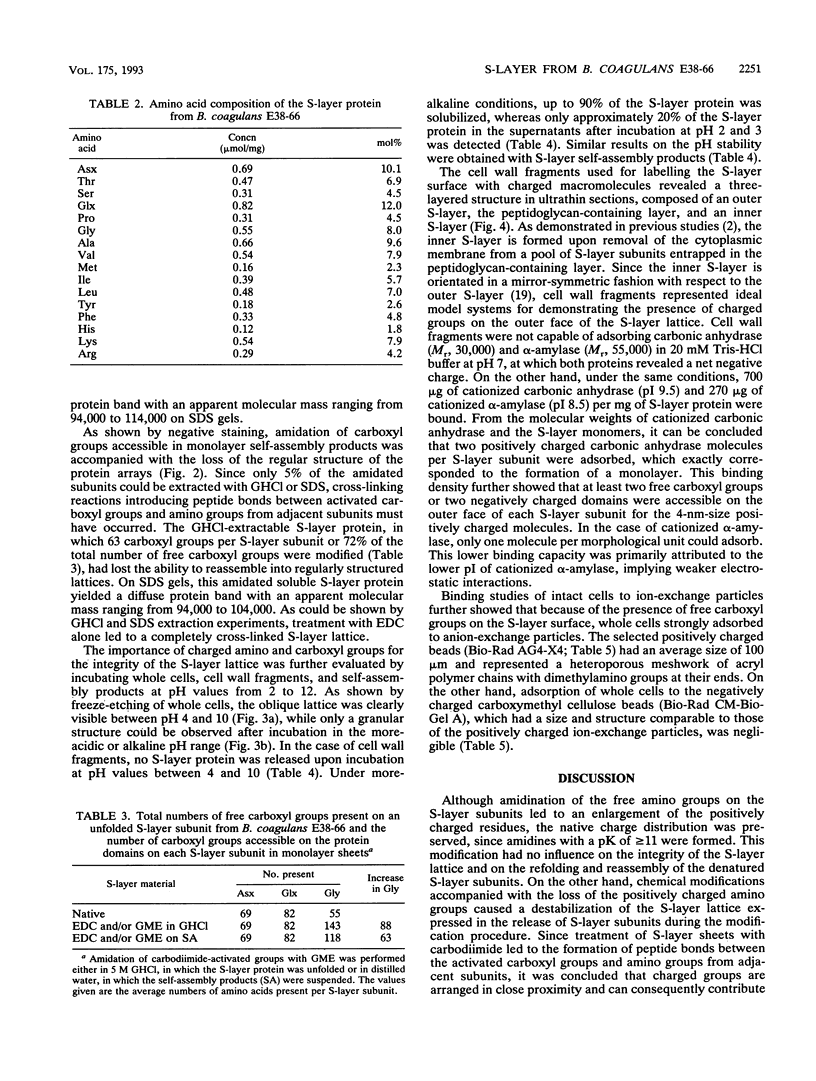Abstract
In this paper, the importance of charged amino and carboxyl groups for the integrity of the cell surface layer (S-layer) lattice from Bacillus coagulans E38-66 and for the self-assembly of the isolated subunits was investigated. Amidination of the free amino groups which preserved their positive net charge had no influence on both. On the other hand, acetylation and succinylation, which converted the amino groups into either neutral or negatively charged groups, and amidation of carboxyl groups were accompanied by the disintegration or at least by the loss of the regular structure of the S-layer lattice. Treatment of S-layer monolayers with the zero-length cross-linker carbodiimide led to the introduction of peptide bonds between activated carboxyl groups and amino groups from adjacent subunits. This clearly indicated that in the native S-layer lattice the charged groups are located closely enough for direct electrostatic interactions. Under disrupting conditions in which the S-layer polypeptide chains were unfolded, 58% of the Asx and Glx residues could be amidated, indicating that they occur in the free carboxylic acid form. As derived from chemical modification of monolayer self-assembly products, about 90% of the lysine and 70% of the aspartic and glutamic acid residues are aligned on the surface of the S-layer protein domains. This corresponded to 45 amino groups and to 63 carboxyl groups per S-layer subunit. Labelling experiments with macromolecules with different sizes and charges and adsorption studies with ion-exchange particles revealed a surplus of free carboxyl groups on the inner and on the outer faces of the S-layer lattice. Since the carboxyl groups on the outer S-layer face were accessible only for protein molecules significantly smaller then the S-layer protomers or for positively charged, thin polymer chains extending from the surface of ion-exchange beads, the negatively charged sites must be located within indentations of the corrugated S-layer protein network. This was in contrast to the carboxyl groups on the inner S-layer face, which were found to be exposed on elevations of the S-layer protein domains (D. Pum, M. Sára, and U.B. Sleytr, J. Bacteriol. 171:5296-5303, 1989).
Full text
PDF






Images in this article
Selected References
These references are in PubMed. This may not be the complete list of references from this article.
- Beveridge T. J., Graham L. L. Surface layers of bacteria. Microbiol Rev. 1991 Dec;55(4):684–705. doi: 10.1128/mr.55.4.684-705.1991. [DOI] [PMC free article] [PubMed] [Google Scholar]
- Breitwieser A., Gruber K., Sleytr U. B. Evidence for an S-layer protein pool in the peptidoglycan of Bacillus stearothermophilus. J Bacteriol. 1992 Dec;174(24):8008–8015. doi: 10.1128/jb.174.24.8008-8015.1992. [DOI] [PMC free article] [PubMed] [Google Scholar]
- Danon D., Goldstein L., Marikovsky Y., Skutelsky E. Use of cationized ferritin as a label of negative charges on cell surfaces. J Ultrastruct Res. 1972 Mar;38(5):500–510. doi: 10.1016/0022-5320(72)90087-1. [DOI] [PubMed] [Google Scholar]
- Galella G., Smith D. B. The cross-linking of tubulin with imidoesters. Can J Biochem. 1982 Jan;60(1):71–80. doi: 10.1139/o82-010. [DOI] [PubMed] [Google Scholar]
- Gounaris A. D., Perlmann G. E. Succinylation of pepsinogen. J Biol Chem. 1967 Jun 10;242(11):2739–2745. [PubMed] [Google Scholar]
- Haynes R., Osuga D. T., Feeney R. E. Modification of amino groups in inhibitors of proteolytic enzymes. Biochemistry. 1967 Feb;6(2):541–547. doi: 10.1021/bi00854a023. [DOI] [PubMed] [Google Scholar]
- Hovmöller S., Sjögren A., Wang D. N. The structure of crystalline bacterial surface layers. Prog Biophys Mol Biol. 1988;51(2):131–163. doi: 10.1016/0079-6107(88)90012-0. [DOI] [PubMed] [Google Scholar]
- Inman J. K., Perham R. N., DuBois G. C., Appella E. Amidination. Methods Enzymol. 1983;91:559–569. doi: 10.1016/s0076-6879(83)91051-0. [DOI] [PubMed] [Google Scholar]
- LOWRY O. H., ROSEBROUGH N. J., FARR A. L., RANDALL R. J. Protein measurement with the Folin phenol reagent. J Biol Chem. 1951 Nov;193(1):265–275. [PubMed] [Google Scholar]
- Masuda K., Kawata T. Reassembly of a regularly arranged protein in the cell wall of Lactobacillus buchneri and its reattachment to cell walls: chemical modification studies. Microbiol Immunol. 1985;29(10):927–938. [PubMed] [Google Scholar]
- Messner P., Sleytr U. B. Crystalline bacterial cell-surface layers. Adv Microb Physiol. 1992;33:213–275. doi: 10.1016/s0065-2911(08)60218-0. [DOI] [PubMed] [Google Scholar]
- Montelaro R. C., Rueckert R. R. Radiolabeling of proteins and viruses in vitro by acetylation with radioactive acetic anhydride. J Biol Chem. 1975 Feb 25;250(4):1413–1421. [PubMed] [Google Scholar]
- Perham R. N., Richards F. M. Reactivity and structural role of protein amino groups in tobacco mosaic virus. J Mol Biol. 1968 May 14;33(3):795–807. doi: 10.1016/0022-2836(68)90320-3. [DOI] [PubMed] [Google Scholar]
- Pum D., Sára M., Sleytr U. B. Structure, surface charge, and self-assembly of the S-layer lattice from Bacillus coagulans E38-66. J Bacteriol. 1989 Oct;171(10):5296–5303. doi: 10.1128/jb.171.10.5296-5303.1989. [DOI] [PMC free article] [PubMed] [Google Scholar]
- Sleytr U. B., Glauert A. M. Ultrastructure of the cell walls of two closely related clostridia that possess different regular arrays of surface subunits. J Bacteriol. 1976 May;126(2):869–882. doi: 10.1128/jb.126.2.869-882.1976. [DOI] [PMC free article] [PubMed] [Google Scholar]
- Sleytr U. B., Messner P. Crystalline surface layers in procaryotes. J Bacteriol. 1988 Jul;170(7):2891–2897. doi: 10.1128/jb.170.7.2891-2897.1988. [DOI] [PMC free article] [PubMed] [Google Scholar]
- Sleytr U. B., Messner P. Crystalline surface layers on bacteria. Annu Rev Microbiol. 1983;37:311–339. doi: 10.1146/annurev.mi.37.100183.001523. [DOI] [PubMed] [Google Scholar]
- Sára M., Pum D., Sleytr U. B. Permeability and charge-dependent adsorption properties of the S-layer lattice from Bacillus coagulans E38-66. J Bacteriol. 1992 Jun;174(11):3487–3493. doi: 10.1128/jb.174.11.3487-3493.1992. [DOI] [PMC free article] [PubMed] [Google Scholar]
- Sára M., Sleytr U. B. Charge distribution on the S layer of Bacillus stearothermophilus NRS 1536/3c and importance of charged groups for morphogenesis and function. J Bacteriol. 1987 Jun;169(6):2804–2809. doi: 10.1128/jb.169.6.2804-2809.1987. [DOI] [PMC free article] [PubMed] [Google Scholar]







